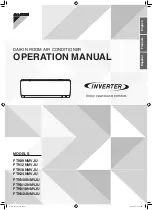
5 OPERATIONS
INFORMATION
i
When there is a drop in the external
temperature, the heating capacity decreases.
If this happens, please use another heating
equipment and unit at the same time. (Make
sure the room is well ventilated if you are
using an equipment that produces fire.) Do
not place any equipment that may produce a
fire where the air outlets of the unit are or
below the unit itself.
Once the unit starts, it takes some time for
the room temperature to rise, as the unit uses
a hot air circulation system to heat the room.
If the hot air rises to the ceiling, causing the
ground area to become cold, it is
recommended that you use a circulating
device (to circulate the indoor air). Please
contact the agent for details.
NOTE
The temperature should below 55°C during
transporing
.
The safety device will be triggered if
the temperature or humidity exceeds these
conditions, and the air conditioner may not run.
for information on the things to note when operating the
system. Operating modes of the outdoor unit (depends
on the indoor unit):
Specialized functions vary with the type of indoor unit.
Refer to the installation/user manuals for more
information.
This symbol indicates that electrical and electronic
products must not be mixed with unsorted household
waste. Do not attempt to dismantle the system on your
own. All works involved in dismantling the system,
handling the refrigerant, oil and other components must
be carried out by authorized installation personnel, and
the works must be carried out in accordance with the
applicable law. The unit must be disposed of and treated
at special treatment facilities for reuse, and recycling. By
making sure that this product is properly handled and
disposed of, you help to minimize the negative impact on
the environment and human health. For more
information, please contact the installation personnel or
local organization.
Cooling.
Heatling.
Mix cooling & heating.
Unit is marked with the following symbols:
5.1 Operating Range
Cooling mode
Heating mode
Outdoor
temperature
Indoor
temperature
-5 (-15
1
)~52°C (DB)
-5 (-15
1
)~27°C (DB) -5 (-15
1
)~19°C (WB)
15~30°C (DB)
15~24°C (WB)
-25~19°C (WB)
Indoor
humidity
Outdoor
temperature
Indoor
temperature
Indoor
humidity
Cooling:15~24°C (WB)
Heaing:15~30°C (DB)
Cooling:15~24°C (WB)
Heaing:15~30°C (DB)
X¢
2
X¢
2
Mix cooling & heating mode
Main cooling
Main Heating
Notes:
1. -15°C cooling is possible only with the single MS box,
otherwise, the minimum allowable cooling operating
temperature is -5°C.
2. Condensation will form on the unit surface and water
dripping out of the unit when the indoor humidity is
&X¢
3. The operating range is for VRF indoor units. There will
be some differences when high temperature (HT) hydro
modules are connected to the system.
5.2 Operating System
5.2.1 About the system operations
5.2.2 Cooling and heating operation of
inverter central A/C
5.2.3 About the heating operation
The operating program varies with different combina-
tions of outdoor unit and controller.
To protect this unit, please turn on the main power supply
12 hours before you start to operate this unit.
If there is a power outage while the unit is running, the
unit will automatically restart its operation when the
power supply resumes.
The indoor units of this air conditioner can be controlled
separately. And the indoor units in the same system can
operate in cooling and heating modes simultaneously.
However, the indoor units connected to the same port of
the mode selection (MS) box cannot operate in heating
and cooling modes simultaneously. Under such cases:
1. If the first turned on indoor unit is operated in cooling
mode, indoor units turned on thereafter in the heating
mode will display the “E0” (mode conflict).
2. If the first turned on indoor unit is operated in heating
mode, indoor units turned on thereafter in the cooling or
fan mode will display the “E0” (mode conflict).
Compared to the cooling operation, the heating
operation takes a longer time.
Need to perform the following operations to prevent the
heating capacity from dropping or prevent cold air from
coming out of the system.
In the heating operation, as the outdoor temperature
decreases, frost may be formed on the heat exchanger
in the outdoor unit, making it more difficult for the heat
exchanger to heat up the air. The heating capacity
decreases, and a defrosting operation needs to be
performed on the system in order for the system to
provide sufficient heat to the indoor unit. At this point, the
indoor unit will show the defrost operation on the display
screen.
The indoor fan motor will automatically stop running so
as to prevent cold air from coming out of the indoor unit
when the heating operation starts. This process will take
some time. This is not a malfunction.
Defrost Operation
51
















































